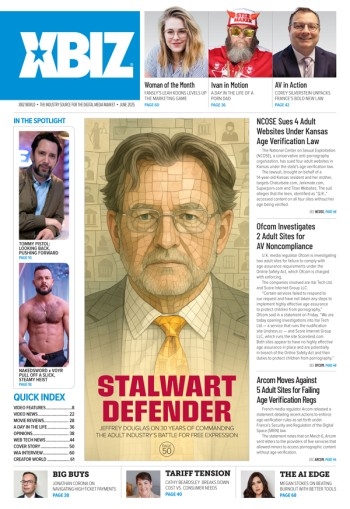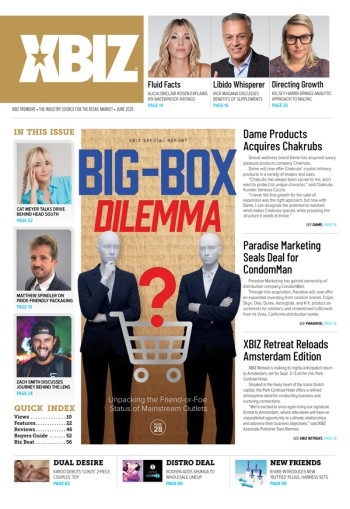Adult film queens such as Jenna Jameson and Tera Patrick often are treated like icons of popular culture, not an underground, marginalized subculture, and Spin Magazine recently added a new sex column by alternative erotica star Joanna Angel (who is often described as the queen of "punk rock porn" or what could be termed "East Village erotica").
Adult stars are increasingly crossing over and popping up in mainstream places these days — a trend that XBIZ discussed with several employees and allies of the adult industry, including Joy King (vice president of special products for Wicked Pictures and a longtime publicist for the Van Nuys, Calif., giant), Michael Atkins (marketing director for NorthStar Associates), Janet Tamborelli (vice president of sales for Los Angeles-based Pulse Distribution) and Jeff Booth (president of the educational Erotic University).
"I personally think the adult entertainment industry is becoming more and more acceptable in the mainstream media," Atkins told XBIZ. "People like Jenna Jameson, Ron Jeremy, Joanna Angel and Tera Patrick have really crossed over. Jessica Jaymes is all over the place now, and Jenna has been in almost every mainstream publication you can think of. Mary Carey is another one who has crossed over. In the 1970s, the media could kind of brush the adult industry under the carpet, but it's hard for them to ignore it at this point."
King, who has been in the adult industry since 1984, took a job in the accounting department of Caballero Home Video and then joined Wicked in 1995 to specifically work with Jameson, has seen a major evolution — for the better — in the industry's relationship with mainstream publications. King said that in the 1970s and 1980s, adult companies were generally wary of the mainstream press and expected negative coverage — and the adult stars who peaked during that era didn't enjoy the type of crossover pop culture appeal that Jameson and Angel are enjoying now.
These days, King said, the Wall Street Journal or the New York Times is more likely to cover the industry in a favorable way, at least from a business perspective. King stressed, however, that the sexual aspects of the industry often are glossed over in large mainstream publications, which tend to focus on Jameson, Angel and others as entrepreneurs and businesspeople rather than as sexual icons.
Adult and Mainstream
"I often hear that the line between adult and mainstream is going to become gray, but I don't believe that," King told XBIZ. "As much money as this industry makes, I don't believe that we will ever be considered totally mainstream in my lifetime. We're mainstream in
terms of all the revenue we generate, but in terms of social acceptance, we will never reach that level. When you're talking about the adult industry as a business model and analyzing business trends, people can accept that. But the mainstream media still struggles with the concept of people having sex in front of a camera. It's OK for the media to look at the industry as a business as long as they don't
get too wrapped up in what is going on sexually."
But King was quick to add that adult stars and the adult industry are, generally speaking, being treated much more favorably by the mainstream press in the 2000s than they were when she joined Caballero's staff 22 years ago.
"When I first got into this business," King recalled, "the mainstream media's coverage of the adult industry was very negative, and the industry shied away from the mainstream press because the only coverage of the industry was always some sort of expose about how horrible they thought the industry was."
King believes that the adult industry's relationship with the mainstream media began to improve considerably around the mid-1990s, when Jameson's marketing campaign really took off and Wicked promoted her as a crossover, pop-culture figure.
Another important event in the adult crossover trend, King said, was a cover story that Frank Rich wrote for the New York Times Magazine in 2001; King believes that Rich's piece inspired a lot of other mainstream publications to cover the industry and recognize Jameson and other adult stars as smart entrepreneurs.
"Frank Rich wrote what I think was probably the best, most unbiased piece of journalism about the porn industry," King said. "Frank's goal was to look at the industry from a business perspective, and he accomplished that. That article was such a defining moment for the industry because we were acknowledged as a legitimate business. It was a refreshing change from some sort of expose on your naughty neighbor shooting porn next door, which was the type of coverage we were used to. To have a writer for the New York Times acknowledge our industry as a business force was very gratifying."
Booth, who has a long journalistic resume in addition to his educational work with Erotic University, told XBIZ that while he sees the crossover status of Jameson, Angel, Jeremy and others as a very positive thing for the adult industry, the mainstream media is still up against a considerable amount of erotophobia in the U.S.
Booth emphasized that when America's mainstream publications cover the adult industry, the focus usually is on business or technology, not sex, and they are essentially looking at Jameson and Angel as entrepreneurs rather than porn stars.
"Technology is one area of the mainstream press where you see the porn industry covered all the time," Booth said. "Wired does pieces on the porn industry. Sometimes, you read about the porn industry in business publications, but not as much as you're seeing in the technology publications. I read a lot of technology publications, and I see a lot of articles focusing on whatever technology is being embraced or utilized in the adult industry, but those articles aren't really talking about sex — and that makes it OK."
The increased exposure that the adult industry is receiving in the mainstream media is something that greatly troubles the Christian Right. The American Family Association, for example, has been quite critical of the Los Angeles Times' willingness to assign articles focusing on the business and technological side of erotic entertainment. And Booth asserted that if the adult industry is going to combat the anti-erotica efforts of the Christian Right, it needs more intelligent, articulate spokespeople such as Jameson and Angel.
'Normalize' Industry?
"The whole key is to normalize the adult industry, which is what Jenna Jameson is doing," Booth said. "Jenna is very articulate and very smart, and the industry needs to find more people like that and put them out front in the mainstream. The more voices the adult industry has out there, the better. We need more voices from inside the industry talking about the industry in a positive way."
Tamborelli theorizes that if more adult performers market themselves successfully, the mainstream media's desire to cover the adult industry will continue to increase in the future.
"People in the mainstream media are opening their eyes and realizing that the adult entertainment industry isn't just one big orgy — it is a legitimate business and is really a very corporate world," she said. "There is a lot of crossover going on between mainstream and adult. Jenna Jameson and Joanna Angel are very accepted outside of the adult industry, and there is a lot more curiosity about the adult world. In the next few years, I think you'll be seeing even more crossover than you're seeing now."




